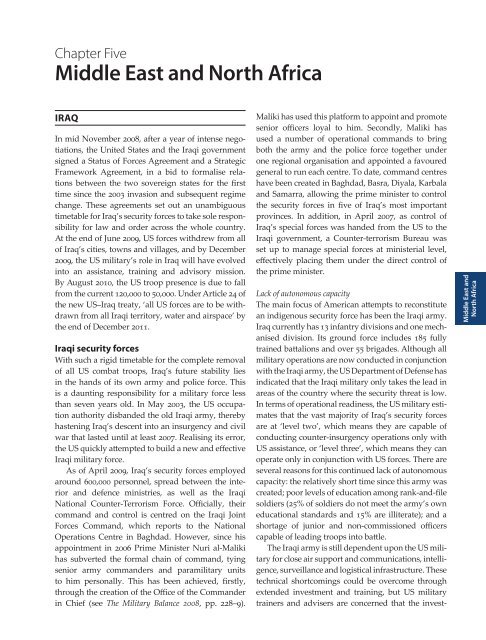Create successful ePaper yourself
Turn your PDF publications into a flip-book with our unique Google optimized e-Paper software.
Chapter Five<br />
Middle East and North Africa<br />
IRAQ<br />
In mid November 2008, after a year of intense negotiations,<br />
the United States and the Iraqi government<br />
signed a Status of Forces Agreement and a Strategic<br />
Framework Agreement, in a bid to formalise relations<br />
between the two sovereign states for the first<br />
time since the 2003 invasion and subsequent regime<br />
change. These agreements set out an unambiguous<br />
timetable for Iraq’s security forces to take sole responsibility<br />
for law and order across the whole country.<br />
At the end of June 2009, US forces withdrew from all<br />
of Iraq’s cities, towns and villages, and by December<br />
2009, the US military’s role in Iraq will have evolved<br />
into an assistance, training and advisory mission.<br />
By August 2010, the US troop presence is due to fall<br />
from the current 120,000 to 50,000. Under Article 24 of<br />
the new US–Iraq treaty, ‘all US forces are to be withdrawn<br />
from all Iraqi territory, water and airspace’ by<br />
the end of December 2011.<br />
Iraqi security forces<br />
With such a rigid timetable for the complete removal<br />
of all US combat troops, Iraq’s future stability lies<br />
in the hands of its own army and police force. This<br />
is a daunting responsibility for a military force less<br />
than seven years old. In May 2003, the US occupation<br />
authority disbanded the old Iraqi army, thereby<br />
hastening Iraq’s descent into an insurgency and civil<br />
war that lasted until at least 2007. Realising its error,<br />
the US quickly attempted to build a new and effective<br />
Iraqi military force.<br />
As of April 2009, Iraq’s security forces employed<br />
around 600,000 personnel, spread between the interior<br />
and defence ministries, as well as the Iraqi<br />
National Counter-Terrorism Force. Officially, their<br />
command and control is centred on the Iraqi Joint<br />
Forces Command, which reports to the National<br />
Operations Centre in Baghdad. However, since his<br />
appointment in 2006 Prime Minister Nuri al-Maliki<br />
has subverted the formal chain of command, tying<br />
senior army commanders and paramilitary units<br />
to him personally. This has been achieved, firstly,<br />
through the creation of the Office of the Commander<br />
in Chief (see The Military Balance 2008, pp. 228–9).<br />
Maliki has used this platform to appoint and promote<br />
senior officers loyal to him. Secondly, Maliki has<br />
used a number of operational commands to bring<br />
both the army and the police force together under<br />
one regional organisation and appointed a favoured<br />
general to run each centre. To date, command centres<br />
have been created in Baghdad, Basra, Diyala, Karbala<br />
and Samarra, allowing the prime minister to control<br />
the security forces in five of Iraq’s most important<br />
provinces. In addition, in April 2007, as control of<br />
Iraq’s special forces was handed from the US to the<br />
Iraqi government, a Counter-terrorism Bureau was<br />
set up to manage special forces at ministerial level,<br />
effectively placing them under the direct control of<br />
the prime minister.<br />
Lack of autonomous capacity<br />
The main focus of American attempts to reconstitute<br />
an indigenous security force has been the Iraqi army.<br />
Iraq currently has 13 infantry divisions and one mechanised<br />
division. Its ground force includes 185 fully<br />
trained battalions and over 55 brigades. Although all<br />
military operations are now conducted in conjunction<br />
with the Iraqi army, the US Department of Defense has<br />
indicated that the Iraqi military only takes the lead in<br />
areas of the country where the security threat is low.<br />
In terms of operational readiness, the US military estimates<br />
that the vast majority of Iraq’s security forces<br />
are at ‘level two’, which means they are capable of<br />
conducting counter-insurgency operations only with<br />
US assistance, or ‘level three’, which means they can<br />
operate only in conjunction with US forces. There are<br />
several reasons for this continued lack of autonomous<br />
capacity: the relatively short time since this army was<br />
created; poor levels of education among rank-and-file<br />
soldiers (25% of soldiers do not meet the army’s own<br />
educational standards and 15% are illiterate); and a<br />
shortage of junior and non-commissioned officers<br />
capable of leading troops into battle.<br />
The Iraqi army is still dependent upon the US military<br />
for close air support and communications, intelligence,<br />
surveillance and logistical infrastructure. These<br />
technical shortcomings could be overcome through<br />
extended investment and training, but US military<br />
trainers and advisers are concerned that the invest-<br />
Middle East and<br />
North Africa


